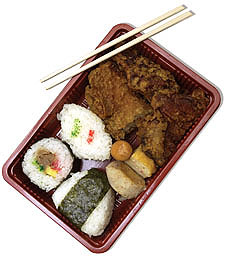Food for Thought
Community colleges partner to bring Smithsonian exhibit to Hawaiʻi



Key Ingredients explores food across America, including Hawaiʻi’s fascination with Spam and plate lunches
"You are what you eat," goes the popular saying. But according to a new exhibit touring three islands, we are defined not just by what we eat, but by how we grow, cook and serve our food as well. Key Ingredients: America By Food is a nationwide culinary exhibition from the Smithsonian Institution’s Museum on Main Street. The exhibit is presented in Hawaiʻi by the Hawaiʻi Council for the Humanities with support from three of the University of Hawaiʻi community colleges with culinary arts programs. It opens June 28, 2008 at Kapiʻolani Community College and travels to other campus and community locations.
"Our focus will be on Hawaiʻi as a separate yet equal part of the whole American experience," says Loretta Pang, council scholar for the project and professor emeritus of history at Kapiʻolani. The exhibition’s local segment—Hawaiʻi: A Place Apart—was developed at the college with input from all the campuses. It traces the islands’ food history from pre-contact sustainable agriculture through the missionary era, commercial cash-crop farming, importation of cattle and Spanish cowboys that started Hawaiʻi’s beef and dairy industries and laborers immigrating to the plantations. It also includes WWII and the Vietnam war, the rise of the tourism and decline of the sugar and pineapple industries.
"Now we’re finding the future in the past thanks to today’s refocus on diversified agriculture and sustainability," notes Louise Pagotto, Kapiʻolani’s interim vice chancellor for academic affairs. Pagotto hopes to hear from islanders with stories to share, perhaps about the days when rice took the place of taro and became a major cash-crop export, or of food shortages during WWII when Hawaiʻi residents embraced canned goods like Vienna sausages and Spam.
The exhibition’s displays, historic photos and artifacts reveal a continually changing cultural smorgasbord. Japanese, Chinese, Filipino, Korean and other immigrant plantation laborers’ field lunches evolved into today’s plate lunches, lunch wagons and ubiquitous plastic-box bentos, explains Kapiʻolani Culinary Arts Educational Specialist Daniel Leung. "The original bentos—Japanese for 'packed meal'—were little boxes stacked on top of each other with the hot rice at the bottom so the steam would heat food in the upper layers."
On view will be cooking utensils and equipment from Hawaiʻi’s many cultures, menus from steamships carrying the first well-heeled tourists to island shores and panels detailing the sociological and political aspects of food across America. Even the effects of marketing on eating habits are addressed, as are controversies over commercial development of agricultural land and attempts to genetically engineer taro.
"We want this exhibition to stimulate thinking and discussion," emphasizes Leung.
Maui Community College is the tour’s final whistle stop in Hawaiʻi. "Our people are passionate about sustainability and environmental stewardship, and that’s where our exhibit focus will be," says Suzette Robinson, vice chancellor for academic affairs. Maui students already can opt for reusable woven bags and washable plates instead of disposable plastic at the food court. The culinary staff transforms unused agricultural by-products into tasty pineapple and wine jellies. And the campus’ Sustainable Living Institute researches ways to recycle and use alternate energy sources.
The Maui organizers plan to kick off their Key Ingredients exhibition with a celebration of ethnic foods.
At all venues, look for dinner lectures, cooking demos and classes, appearances by well-known chefs, storytelling events, activities for school groups and possibly a food film festival. Most will be free. Spam musubi, kim chee, haupia pudding and Portuguese bean soup, anyone?
Where to see Key Ingredients

Also featured in the exhibit is the growing local interest in cuisine featuring fresh local ingredients like the herbs in Kapiʻolani Community College’s culinary garden
June 28–Aug. 23
Kapiʻolani Community College
Lama Library
Aug. 30–Oct. 20
Kapolei Library
Oct. 27–Jan. 31
Lyman Museum
(in partnership with Hawaiʻi Community College)
Feb. 14–Apr. 12, 2009
Maui Community College
Information on Hawaiʻi exhibits.
Learn more about UH culinary programs by using "View Programs of Study" to select food service; more on the Smithsonian’s exhibit, including mainland exhibition sites through 2010; more on the Hawaiʻi Council for the Humanities.
Food News
Recipe for living healthy
The Kapiʻolani Community College Culinary Arts program’s new book, A DASH of Aloha: Healthy Hawaiʻi Cuisine and Lifestyle, adapts the Dietary Approach to Stop Hypertension (DASH) eating and physical activity plan to the islands’ palate and lifestyle. "A DASH of Aloha is about taking the simplest steps to incorporate healthful rules of thumb into your daily routine, with the long-term goal of achieving a healthier lifestyle," says Chair Ron Takahashi. Included are 70 recipes—based on local tastes and using simply prepared Island-grown fresh ingredients—with nutritional notes and fact charts. The book is available from bookstores or from Watermark Publishing.
Honors for local chefs
Roy’s Restaurant founder Roy Yamaguchi was honored for his achievements and contributions to education, and the Hawaiʻi Regional Cuisine Wall of Fame was unveiled May 10 at Leeward Community College’s Lʻulu, Leeward Culinary Arts Gala. Yamaguchi is the first chef from Hawaiʻi to receive the James Beard Foundation Award and one of 12 chefs credited with founding Hawaiʻi Regional Cuisine. The culinary program fundraiser featured sumptuous food from student, faculty and guest chefs in newly renovated campus culinary facilities.